
| Born: Oct 7, 1885 in Copenhagen, Denmark |
| Died: Nov 18, 1962 (at age 77) in Copenhagen, Denmark |
| Nationality: Danish |
| Famous For: Electron configuration, Copenhagen interpretation, Complementarity, Atomic theory, Aufbau principle, Bohr model, Bohr–Sommerfeld quantization, Bohr–van Leeuwen theorem, Sommerfeld–Bohr theory, BKS theory, and many others |
| Awards: Nobel Prize in Physics (1922), Franklin Medal (1926), Order of the Elephant (1947), and Atoms for Peace Award (1957) |
Niels Henrick David Bohr was a physicist from Denmark. He made substantial contributions to the understanding of quantum mechanics and atomic structure. As a result, he was awarded the Nobel Prize in the field of Physics. Bohr was a promoter and philosopher of scientific research.
Early Life
Niels was born in Copenhagen, Denmark in October, 1885. He was the second born of three children. He went to Gammelhon Latin School and Copenhagen University. He majored in Physics under Professor Christian Christiansen who was the only Physics professor there at the time. Bohr also studied mathematics and astronomy.
In 1905, Bohr conducted experiments from his father’s lab at the university since his university did not have a physics lab. To carry out his experiments Bohr had to be his own glass blower, making test tubes with elliptical cross sections.
Life and Contributions
Bohr worked on a theoretical piece regarding the absorption of alpha rays that was published in Philosophical Magazine in 1913. He introduced concepts that were borrowed from quantum theory.
Bohr had an institute which served as a center for researchers who were interested in quantum mechanics or related fields in the 1920’s and 1930’s. In this period many of the world’s best theoretical physicists spent time there. In 1922, Bohr won the Nobel Prize in Physics for his research on the structure of atoms and the radiation they emit. This award recognized his leading work in quantum mechanics.
In 1930, Bohr began research on the composition of the atomic nucleus, their transmutations and their disintegrations. Bohr contributed majorly to clarifications of problems that were experienced in quantum physics.
Later Life
Bohr was married to Margethe in 1912 in a civil ceremony in the town hall. They had six children, all sons. He received a lot of accolades and honors in his lifetime and was also depicted on a banknote in 1997. Bohr died at the age of 77 in 1962, leaving behind a physics legacy.